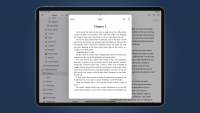The Harried Mystery Hero(ine) Or, How to Write a Mystery (Easy)
By G. Miki Hayden
Instructor at Writer's Digest University online and private writing coach
firstwriter.com – Monday January 29, 2024
Nothing is so essential to the successful creation of the mystery—from the grittiest work of fiction to the most comedic—as presenting the protagonist’s unrelenting pursuit of the McGuffin* against all possible odds and impossible barriers.
The secret to generating the story’s drama—and, again, even a funny mystery needs plenty of drama—is to never allow your main character a moment’s rest. Even when the hero is relaxing by the pool drinking an expensive wine accompanied by caviar on toast points, he must at the very least, be worrying himself to a veritable frazzle. If he sleeps, he sleeps badly—maybe a sleep interrupted by the ringing of the phone and appalling news (another murder? the suspect has escaped?). If he meets a woman he could love, she’s either a plant working to undermine his investigation, in grave danger herself, or sometimes even the killer (yup).
Though I seem to be making light of your protagonist’s troubles, this is the way the story has to proceed, no matter the subgenre or the tone. Your job is to attach us to the character and then do your best to drive him or her over the edge, literally or figuratively, or both. That, then, is drama.
How does the writer keep this drive toward the McGuffin and its opposition going? In any way possible. The barriers to the protagonist’s success must be continual. Yes, of course, he or she needs to make a little progress toward the goal. After all, eventually, you must come to the end of the novel and the mystery’s conclusion, but in the meantime, those victories absolutely must be terribly hard won.
You don’t want to ever let up on the problems the protagonist must face. She can’t get into the hotel to look at the scene of the crime. She’s warned off from interviewing the grieving widow. The document she thought was real turns out to be a fake. Of course she will have momentary flashes of genius or lightning will strike and she’ll impersonate a housemaid to enter the suite where the doctor was killed, then she’ll send a note to the grieving widow who once loved the protagonist’s father. And, later, the document turns out to be genuine though falsely presented as a forgery.
Still, nothing must ever come easy to your central character—after all, because where is the excitement in that kind of thing? Tension and release from tension constitute drama and form the steps leading forward through the story.
Certainly the incidents that build to the novel’s climax will become ever more fraught, as the major story line advances to create the dazzling bell-curvelike structure of the arc.
In writing this marketable mystery of yours, you’ll have to stay aware of the need to not just start the mystery at a high point, but to ratchet up the internal or external stakes as you go along. That’s why many authors introduce the threat of death to the very protagonist or to a loved one at around the last third of the book. As the ante must rise nearing the climax of the story, often you can’t get any higher a risk than danger to the protagonist, or the protag’s love interest. Of course in a more cerebral story, the ultimate in jeopardy might be a thrust against the investigator’s sense of self. What if he fails? Or seems to? Or is framed by the perpetrator? He might have to quit the police department. Or she might begin her drug use again.
The mystery form, or whatever you call the subgenre you hope to undertake, has become a staple for the reading public exactly because it offers the most extreme elements we will ever find in life or in fiction—the greatest hazards both physical and moral along with the ultimate satisfaction of overcoming terrible odds, and often, evil itself.
If you stay within this set of parameters outlined right here and maintain the conflict unrelentingly despite the main character’s increasing knowledge and advancement toward achieving the McGuffin, you will have just about the whole of your plot settled like that. The plot, in short, doesn’t have to be clever or convoluted or present tremendous wit or elaborate detail, it simply must keep the reader riveted by alternating the carrot of hope and the stick of fear. As flesh and blood, your readers participate in a similar contentious striving daily, but reading about a character in a circumstance of exaggerated tribulation produces the catharsis that art is intended to finally result in.
*McGuffin: That thing being sought—most likely the killer.
About the Author
G. Miki Hayden is a short story Edgar winner. She teaches a mystery writing and a thriller writing and other writing classes at Writer's Digest online university. The third edition of her Writing the Mystery is available through Amazon and other good bookshops. She is also the author of The Naked Writer, a comprehensive, easy-to-read style and composition guide for all levels of writers.
Miki's most recent novel out is Dry Bones, a police procedural from Down & Out Books. The New York Times gave her Pacific Empire a rave and listed it on that year's Summer Reading List. Miki is a short story Edgar winner for "The Maids," about the poisoning of French slave holders in
"Holder, Oklahoma Senior Police Officer Aaron Clement is out for justice above all, even if he irritates the local hierarchy. Hayden in Dry Bones gives us nothing-barred investigation and plenty of nitty-gritty police procedure—which makes for a real page turner." — Marianna Ramondetta, author of The Barber from Palermo




 Murder mystery author Jane Harper has six tips for writing a bestselling novel
Murder mystery author Jane Harper has six tips for writing a bestselling novel Ross MacKenzie's whirlwind guide to writing mystery
Ross MacKenzie's whirlwind guide to writing mystery One Neat Trick to Writing Great Mystery Plots
One Neat Trick to Writing Great Mystery Plots Peng Shepherd On Writing A Choose-You-Own-Adventure Speculative Mystery
Peng Shepherd On Writing A Choose-You-Own-Adventure Speculative Mystery 9 tips for writing your own murder mystery, from a published author
9 tips for writing your own murder mystery, from a published author Removing the Mystery From Mystery Writing: 13 Tricks Used by Acclaimed Novelists
Removing the Mystery From Mystery Writing: 13 Tricks Used by Acclaimed Novelists On Writing A Mystery That Defies Rationality
On Writing A Mystery That Defies Rationality Writing a Romance versus Writing a Mystery
Writing a Romance versus Writing a Mystery The World Of Book Publishing Is A Mystery To Many, So We Did Our Best To Show You Behind-The-Scenes
The World Of Book Publishing Is A Mystery To Many, So We Did Our Best To Show You Behind-The-Scenes Book proposal writing made easy
Book proposal writing made easy How to write a book: 11 tips on creating a bestseller from published authors
How to write a book: 11 tips on creating a bestseller from published authors How to write like Ernest Hemingway
How to write like Ernest Hemingway How to write a novel in Ulysses on iPadOS
How to write a novel in Ulysses on iPadOS Could you write a crime novel? Candice Fox has some advice for would-be authors
Could you write a crime novel? Candice Fox has some advice for would-be authors Rachel Richardson launches the Rich Lit literary rights agency
Rachel Richardson launches the Rich Lit literary rights agency Bridport Prize Memoir Award 2024 competition nears deadline
Bridport Prize Memoir Award 2024 competition nears deadline Spread the Word relaunches London Writers Awards for 2025-2027
Spread the Word relaunches London Writers Awards for 2025-2027 This Online Writing Platform Wants Budding Authors to Plot an Elaborate Murder
This Online Writing Platform Wants Budding Authors to Plot an Elaborate Murder Authors report 'worst ever delays' with advances and royalties as some forced to survive on loans — survey
Authors report 'worst ever delays' with advances and royalties as some forced to survive on loans — survey New Literary Agent Listing: Maria Napolitano
New Literary Agent Listing: Maria Napolitano New Publisher Listing: Cherry Lake Publishing Group
New Publisher Listing: Cherry Lake Publishing Group Unwin Awards submissions open in inaugural year
Unwin Awards submissions open in inaugural year Black Crow Books: new horror publisher aims to open up 'booming' genre to everyone
Black Crow Books: new horror publisher aims to open up 'booming' genre to everyone Sebes & Bisseling hires four new agents as part of major expansion
Sebes & Bisseling hires four new agents as part of major expansion New Literary Agent Listing: Jessica Leeke
New Literary Agent Listing: Jessica Leeke Agatha Christie’s holiday home set to host new writing workshops
Agatha Christie’s holiday home set to host new writing workshops A M Heath reveals plans for 'significant growth' with key promotions
A M Heath reveals plans for 'significant growth' with key promotions Jade Kavanagh and Rebeka Finch step up at Darley Anderson
Jade Kavanagh and Rebeka Finch step up at Darley Anderson Writing Fantasy course launched taught by author Lucy Holland
Writing Fantasy course launched taught by author Lucy Holland
